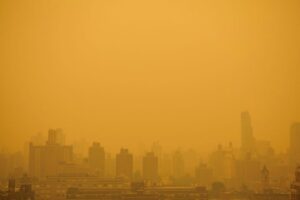The Center for Biological Diversity (CBD) sharply criticized the EPA’s decision to retain the existing secondary standards for nitrogen oxides and particulate matter (PM) without revision.
“The EPA failed to seize this important opportunity to better protect plants and animals from these toxic pollutants,” said Ryan Maher, CBD staff attorney, in the organization’s press release. “Since the EPA’s last review of these pollution standards, the science showing the ecological harm from soot, sulfur and nitrogen air pollution has become more certain. Rather than aligning its standards with this new research, the EPA has chosen to perpetuate dangerous levels of air pollution.”
NAAQS authority
Sections 108 and 109 of the Clean Air Act (CAA) require the EPA to periodically review the National Ambient Air Quality Standards (NAAQS). This involves the review of air quality criteria—the science the standards are based on—and the standards themselves.
Section 109 of the act (42 U.S.C. 7409) directs the administrator to propose and promulgate “primary” and “secondary” NAAQS for pollutants for which air quality criteria are issued (42 U.S.C. 7409(a)). Under Section 109(b)(2), a secondary standard must “specify a level of air quality the attainment and maintenance of which, in the judgment of the Administrator, based on such criteria, is requisite to protect the public welfare from any known or anticipated adverse effects associated with the presence of [the] pollutant in the ambient air.”
Primary standards are designed to protect public health with an adequate safety margin. Secondary standards are designed to protect the public welfare from adverse effects, including those related to effects on soils, water, crops, vegetation, man-made (anthropogenic) materials, animals, wildlife, weather, visibility, and climate; damage to property; transportation hazards; economic values; and personal comfort and well-being.
The six criteria pollutants under the NAAQS are:
- Carbon monoxide (CO)
- Lead (Pb)
- Particulate matter (PM), also known as “soot”
- Ozone (O3)
- Nitrogen dioxide (NO2)
- Sulfur dioxide (SO2)
Current proposed rule
Although the EPA proposed to retain the existing secondary standards for NO2 and PM, its proposed rule calls for:
- The revision of the existing secondary SO2 standard to an annual average, averaged over three consecutive years, with a level within the range from 10 to 15 parts per billion (ppb).
- Revisions to the data-handling requirements for the proposed secondary SO2 NAAQS.
The CBD’s criticism stems from the fact that “the agency has not updated the secondary standards for nitrogen or sulfur air pollution since 1971,” the CBD press release says. “And the three portions of the agency’s secondary soot standards have not been updated since 1987, 1997 and 2006, respectively.”
The CBD previously filed suit against the EPA because the Agency failed to update the NAAQS in a timely manner, as required by law. An agreement reached in that lawsuit required the Agency to finalize its decision on air quality standards by December 10, 2024.
“In developing its proposal, the EPA did not complete the required Endangered Species Act consultation with the U.S. Fish and Wildlife Service and National Marine Fisheries Services on how the levels of air pollution allowed by the proposed standards would affect threatened and endangered plants and animals,” the CBD press release adds.
“The EPA is required to assess harms to endangered species when it sets pollution standards,” said Maher in the CBD press release. “Air pollution standards must protect endangered plants and wildlife, but the agency failed to follow the law, or the science, to fully address this toxic air pollution’s harms to the environment.”
Burning fossil fuels produces NO2, which contributes to ozone formation, acid rain, nutrient pollution, and poor visibility, the CBD says. Nutrient pollution increases harmful algae growth in aquatic ecosystems, which decreases life-sustaining levels of oxygen in water bodies. Nutrient pollution in groundwater can also contaminate drinking water.
Burning fossil fuels also results in soot, which results in reduced visibility and reduced nutrients in soil. Reduced soil nutrients results in harm to crops and forests. And, particularly, burning coal contributes to acid rain, which threatens aquatic plants and wildlife and increases plant mortality and reproductive harm on land.
“Acidification of aquatic ecosystems harms the endangered whooping crane by depleting its food resources,” according to the CBD press release. “The whooping crane’s preferred prey, such as aquatic insects, crayfish and frogs, are vulnerable to acidic waters.”
Comments on the proposed rule will be accepted on the federal e-Rulemaking website until June 14, 2024.

